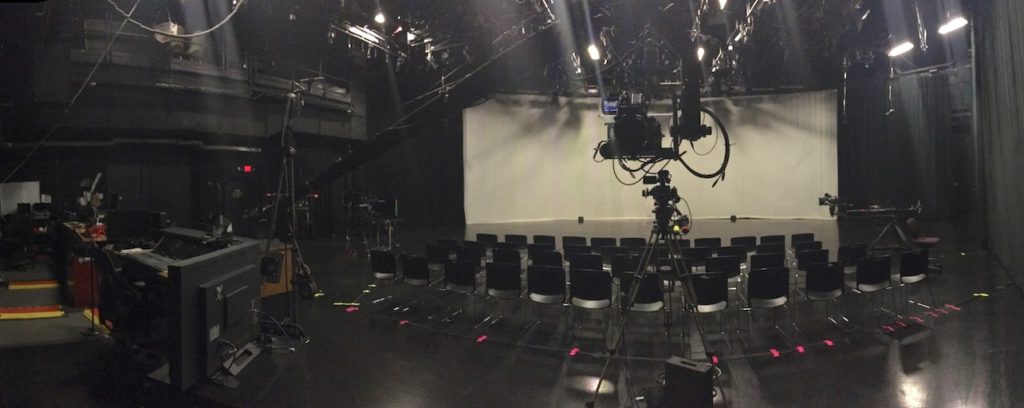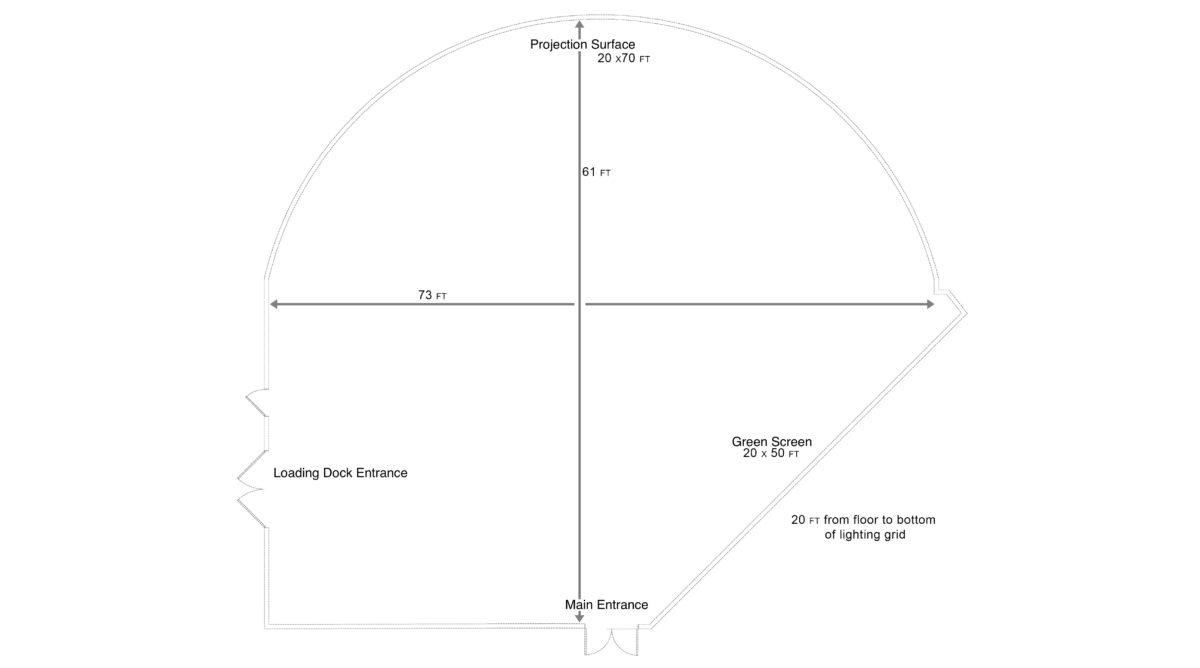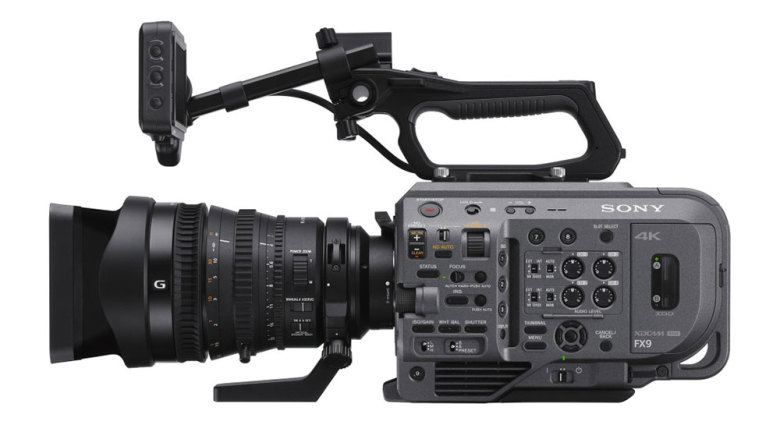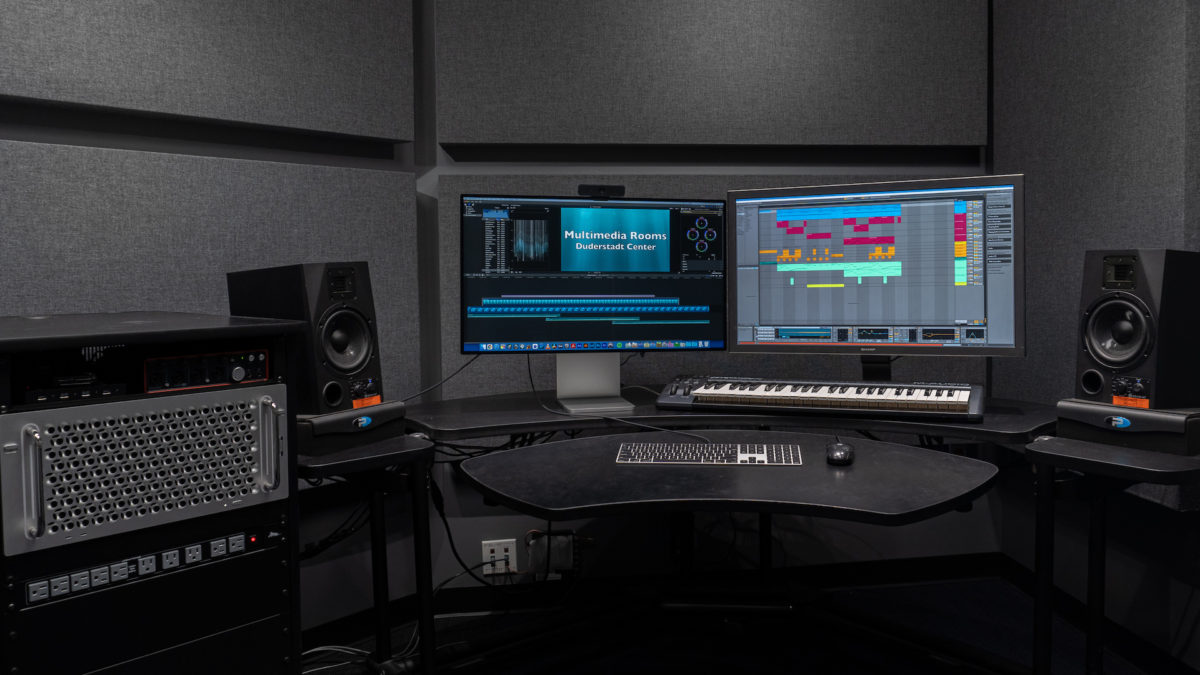Studio Dimensions
Studio Lighting
Cameras
Green Screen
Video Projection
Live Event Switching
Video Streaming
Recording Formats
Post Production & Editing Resources
Studio Policies
Studio Dimensions


The Video Studio is 73 ft at its widest with a maximum depth of 61 ft, and 20 ft from floor to the bottom of the lighting grid. Video Studio Consultants will work with you to determine usable space based upon production requirements.
A Vectorworks rendering of the studio as well as template PDF floor plans are available for download.
Studio Lighting
Lighting is key to producing high-quality video. The video studio has eighteen motorized grids populated with a wide variety of industry standard lighting instruments. Whether filming a tasteful interview, a high-intensity rock band or something in-between, the video studio is equipped to meet the demands of the project. For a detailed list of our lighting instruments or more information regarding our lighting capabilities, please email dc-media-studio-arts@umich.edu.
Cameras

The Video Studio is equipped with six Sony PXW-FX9 4K cameras. Learn more about the capabilities of the PXW-FX9 at Sony’s resource page.
To Top of Page
Green Screen
The Video Studio houses an impressive 50 ft wide green screen and accompanying 32 ft by 36 ft floor insert to accommodate projects that require CGI elements and chroma key compositing. The vastness of the surface makes the Video Studio a viable space for capturing full-body green screen work and dance. A dedicated green screen lighting setup ensures footage is ‘keyed’ with ease by producing even light across the full surface of the screen.
To Top of Page
Video Projection
Permanently installed are two 12,000 lumens Epson Pro L1505U Laser Projectors used to create a combined 3840×1080 “Pixel Space” on the studio cyclorama. This produces a 64 ft wide by 17 ft high image. Within that “Pixel Space” video can be played back centered, scaled to fit, or positioned as desired.
Important: if you want your video or image projection to fill the full surface, your content will need to be created using the 3840×1080 dimensions.
Two additional projectors are available upon request for projection mapping and/or other projecting needs in the studio. Please contact us for further details and technical specifications. Controlling the projectors is a powerful Mac Pro loaded with Touch Designer (PC/Mac), QLAB (Mac), Resolume (Mac), and VLC (PC/Mac).
To Top of Page
Live Event Video Switching
In addition to recording individual camera feeds, a live video switch, similar to what you would see from a live concert or sporting event, is performed and recorded. This live-switched video, which is a real-time edit of camera footage, projections and computer sources, is referred to as the Program feed, and is a single file that can be used to share your video before any additional editing is completed. The program feed is also used for live streaming.
To Top of Page
Video Streaming
The Video Studio is capable of streaming live events to YouTube and/or Vimeo via Livestream upon request. Live event information and links will be posted on the Duderstadt Center webpage under “Upcoming Events.” After the performance, the client has the option for the performance to become “Unlisted” on YouTube.
Video Streaming from the Video Studio must adhere to YouTube’s Community Guidelines.
To Top of Page
Recording Formats
The Sony PXW-FS7 can record in multiple resolutions and frame rates. These settings impact the size and duration of the media files created. Performances recorded live also have a Hot Switch mix recorded at 1080p 29.97 fps in the ProRes 422 format which is independent of the camera format choice . This is a matrix of formats commonly used in the Video Studio.
High Speed Frame Rates: The PXW-FS7 is capable of capturing up to 180 fps when recording at XAVC-I 1080. Storage requirements and duration requirements increase proportionally as FPS increase.
To Top of Page
Post Production & Editing Resources

Once a production wraps, all media assets (camera files, live-switched program feed, audio files and mixes, still photos, etc) are copied to a client provided personal hard drive as well as the Duderstadt Center’s high speed internal network storage. Following your shoot you will meet with a consultant and have the following options:
- Review your footage and choose to work off of your personal hard drive and computer.
- Gain access to our high speed network storage and reservable Multimedia Rooms for 45 days.
For classes that need access to media, we can provide information and directions that will allow participants to download content to their own hard drives from any computer in Groundworks or Multimedia Rooms.
Hard Drive Selection: Depending on number of cameras, days/shows, storage requirements will vary. Minimum recommended specs should be 7,200 RPM hard drives with a USB-3 connector.
Clients are responsible for providing hard drives with enough storage space during the week of their production. The hard drives need to be Mac formatted and empty.
Hard drive size recommendations are based on total record duration. For example, if the cameras record for a total of 80 minutes throughout your filming sessions, you should plan on providing a 4TB hard drive to acquire your footage.
2TB
4TB
- Glyph Technologies 4TB Blackbox Pro 7200 rpm USB 3.1 Gen 2 Type-C External Hard Drive
- WD 4TB My Passport SSD USB 3.2 Gen 2 Type-C Portable SSD
6TB
8TB
16TB
Questions regarding Video Studio production specific post-production assistance may be directed to: dc-media-studio-arts@umich.edu
General inquires and questions regarding post-production assistance may be directed to: groundworks@umich.edu
To Top of Page
Studio Policies
A studio technician must be present during any and all use of the facility. The studio technician must approve all equipment and properties brought into the studio. Liquids, open flames, flammable materials, or materials that create other hazards are not allowed in the studio. Repair of damage to the facilities, tools or equipment during use (including setup, rehearsal, production, and post-production) will be billed to the project. Costs incurred to remove any material after the approved de-installation date will be charged to the project.